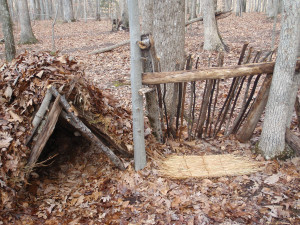 Imagine this. You are enjoying a beautiful ride through the woods. The sun is starting to set, but you are not worried. You have a headlamp and it isn’t cold yet. You can just enjoy the bright pink sky and the fresh air.
Imagine this. You are enjoying a beautiful ride through the woods. The sun is starting to set, but you are not worried. You have a headlamp and it isn’t cold yet. You can just enjoy the bright pink sky and the fresh air.
But suddenly a deer runs by and startles you, and you slip off the trail down a ten-foot drop. You try to get back up, but pain shoots up your leg, and it won’t hold your weight. You pull out your cell phone to call for help, but you don’t have even one bar. What do you do now?
You should avoiding going out into the wilderness alone, but you might find yourself in a situation like this at some point, whether on a bicycle or on a hike. If you do find yourself injured and out of cell phone range, don’t panic. You can take steps to survive and to help rescuers find you.
Preparation
Simply informing a loved one of your trip’s plans could save your life. Besides packing essentials, you should have at least told someone where you were going and when you planned to get back. If you did, that person can call you when you don’t return home on time and alert authorities when you can’t be reached. That person will also know where to send search and rescue if you had previously told them your trip details.
You should also pack a coat, a multi-tool, and matches. Then it will be easier to stay warm, build a shelter, and start a fire. Preparation is very important. If you did not prepare for emergencies, you will wish that you had.
How Your Cell Phone Can Help
Your cell phone might seem useless without reception, but it could still save you. Cell phones connect periodically with nearby cell towers, which leaves a digital trail rescuers can trace. A signal which is too weak to make a call or send a text might be strong enough to make this kind of connection, sometimes called a digital handshake. Rescuers can determine your approximate location based on the towers which connect with your cell phone.
It is okay to turn off your cell phone to conserve battery life, but you should leave it on for a bit every so often so your phone can continue to make digital handshakes with nearby towers. You could turn it on briefly each time you move to a new location to further track your whereabouts.
You should also try calling 911, even if you don’t have cell coverage. Even if your call doesn’t go through, it might show up on a call history that rescuers can check.
Sending a text requires less bandwidth than a call does, so try texting a loved one a few times. It might eventually go through.
Survival
Make sure you keep yourself warm. Cold is the main threat you face. Water and food are important, but not as serious unless you are stranded for days. Being stranded in cold night temperatures is dangerous year-round.
If you can, make yourself a shelter. The shelter needs to keep you warm and dry. It does not need to look good. One boy-scout saved himself from hypothermia by burying himself in pine needles and other debris. Build a fire if you can. It will it keep you warm and make you more noticeable to rescuers.
Most of all, it is important to fight off panic. Your survival depends on your ability to make good decisions under pressure. Don’t give up and stay calm. The right mindset will help you make those decisions that could save your life.
Be prepared and stay safe during your next ride.
Photo by vastateparksstaff via Flickr under Creative Commons License.
